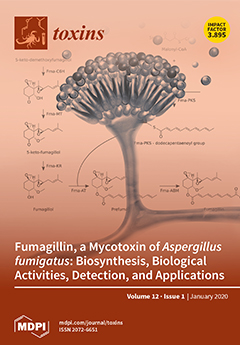Aflatoxins (AF) are highly toxic compounds produced by
Aspergillus section
Flavi. They spoil food crops and present a serious global health hazard to humans and livestock. The aim of this study was to examine the phylogenetic relationships among aflatoxigenic and non-aflatoxigenic
Aspergillus
[...] Read more.
Aflatoxins (AF) are highly toxic compounds produced by
Aspergillus section
Flavi. They spoil food crops and present a serious global health hazard to humans and livestock. The aim of this study was to examine the phylogenetic relationships among aflatoxigenic and non-aflatoxigenic
Aspergillus isolates. A polyphasic approach combining phylogenetic, sequence, and toxin analyses was applied to 40
Aspergillus section
Flavi isolates collected from eight countries around the world (USA, Philippines, Egypt, India, Australia, Indonesia, China, and Uganda). This allows one to pinpoint the key genomic features that distinguish AF producing and non-producing isolates. Based on molecular identification, 32 (80%) were identified as
A. flavus, three (7.5%) as
A. parasiticus, three (7.5%) as
A. nomius and one (2.5%) as
A. tamarii. Toxin analysis showed that 22 (55%)
Aspergillus isolates were aflatoxigenic. The majority of the toxic isolates (62.5%) originated from Egypt. The highest aflatoxin production potential was observed in an
A. nomius isolate which is originally isolated from the Philippines. DNA-based molecular markers such as random amplified polymorphic DNA (RAPD) and inter-simple sequence repeats (ISSR) were used to evaluate the genetic diversity and phylogenetic relationships among these 40
Aspergillus isolates, which were originally selected from 80 isolates. The percentage of polymorphic bands in three RAPD and three ISSR primers was 81.9% and 79.37%, respectively. Analysis of molecular variance showed significant diversity within the populations, 92% for RAPD and 85% for ISSR primers. The average of Polymorphism Information Content (PIC), Marker Index (MI), Nei’s gene diversity (H) and Shannon’s diversity index (I) in ISSR markers are higher than those in RAPD markers. Based on banding patterns and gene diversities values, we observed that the ISSR-PCR provides clearer data and is more successful in genetic diversity analyses than RAPD-PCR. Dendrograms generated from UPGMA (Unweighted Pair Group Method with Arithmetic Mean) cluster analyses for RAPD and ISSR markers were related to the geographic origin.
Full article






